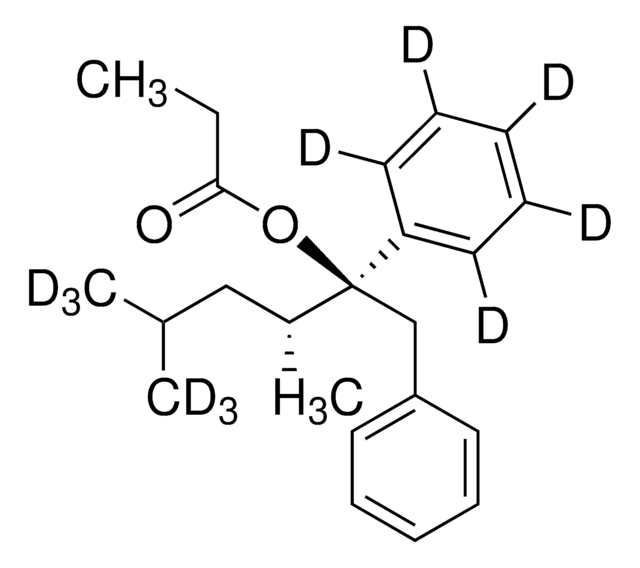P-011
(+)-Propoxyphene solution
1.0 mg/mL in acetonitrile, ampule of 1 mL, certified reference material, Cerilliant®
About This Item
Prodotti consigliati
Grado
certified reference material
Forma fisica
liquid
Caratteristiche
Snap-N-Spike®/Snap-N-Shoot®
Confezionamento
ampule of 1 mL
Produttore/marchio commerciale
Cerilliant®
drug control
Narcotic Licence Schedule A (Switzerland); estupefaciente (Spain); Decreto Lei 15/93: Tabela IA (Portugal)
Concentrazione
1.0 mg/mL in acetonitrile
tecniche
gas chromatography (GC): suitable
liquid chromatography (LC): suitable
applicazioni
forensics and toxicology
Formato
single component solution
Temperatura di conservazione
2-8°C
Stringa SMILE
CCC(=O)O[C@@](Cc1ccccc1)([C@H](C)CN(C)C)c2ccccc2
InChI
1S/C22H29NO2/c1-5-21(24)25-22(18(2)17-23(3)4,20-14-10-7-11-15-20)16-19-12-8-6-9-13-19/h6-15,18H,5,16-17H2,1-4H3/t18-,22+/m1/s1
XLMALTXPSGQGBX-GCJKJVERSA-N
Informazioni sul gene
human ... OPRM1(4988)
Categorie correlate
Descrizione generale
Note legali
Prodotti correlati
Avvertenze
Danger
Indicazioni di pericolo
Classi di pericolo
Acute Tox. 4 Dermal - Acute Tox. 4 Inhalation - Acute Tox. 4 Oral - Eye Irrit. 2 - Flam. Liq. 2
Codice della classe di stoccaggio
3 - Flammable liquids
Classe di pericolosità dell'acqua (WGK)
WGK 2
Punto d’infiammabilità (°F)
35.6 °F - closed cup
Punto d’infiammabilità (°C)
2 °C - closed cup
Certificati d'analisi (COA)
Cerca il Certificati d'analisi (COA) digitando il numero di lotto/batch corrispondente. I numeri di lotto o di batch sono stampati sull'etichetta dei prodotti dopo la parola ‘Lotto’ o ‘Batch’.
Possiedi già questo prodotto?
I documenti relativi ai prodotti acquistati recentemente sono disponibili nell’Archivio dei documenti.
Il team dei nostri ricercatori vanta grande esperienza in tutte le aree della ricerca quali Life Science, scienza dei materiali, sintesi chimica, cromatografia, discipline analitiche, ecc..
Contatta l'Assistenza Tecnica.










